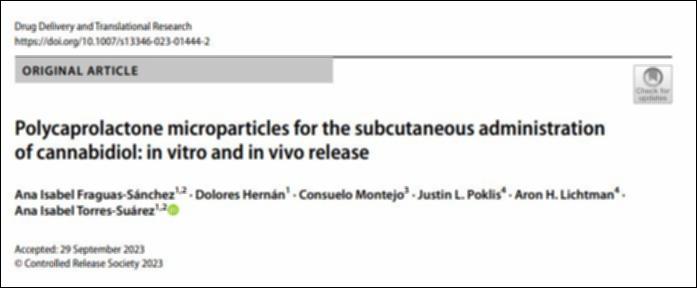Por favor, use este identificador para citar o enlazar este ítem:
http://hdl.handle.net/10637/14785Polycaprolactone microparticles for the subcutaneous administration of cannabidiol: in vitro and in vivo release

Ver/Abrir:
Polycaprolactone_2023.JPG
29,47 kB
JPEG
Ver/Abrir:
Polycaprolactone_montejo_2023.pdf
1,44 MB
Adobe PDF
Ver/Abrir:
Correction_2023.pdf
524,62 kB
Adobe PDF
| Título : | Polycaprolactone microparticles for the subcutaneous administration of cannabidiol: in vitro and in vivo release |
| Autor : | Fraguas Sánchez, Ana Isabel Hernan, Dolores Montejo Rubio, María Consuelo Poklis, Justin L. Lichtman, Aron H. Torres Suárez, Ana Isabel |
| Materias: | Cannabidiol; Cannabinoids; Pharmacokinetics; Polymeric microparticles; Sustained release; Subcutaneous administration |
| Editorial : | Springer |
| Citación : | Fraguas-Sánchez, A.I., Hernán, D., Montejo, C. et al. Polycaprolactone microparticles for the subcutaneous administration of cannabidiol: in vitro and in vivo release. Drug Deliv. and Transl. Res. (2023). https://doi.org/10.1007/s13346-023-01444-2 Fraguas-Sánchez, A.I., Hernán Pérez de la Ossa, D., Montejo, C. et al. Correction to: Polycaprolactone microparticles for the subcutaneous administration of cannabidiol: in vitro and in vivo release. Drug Deliv. and Transl. Res. (2023). https://doi.org/10.1007/s13346-023-01507-4 |
| Resumen : | Cannabidiol (CBD) has become a highly attractive entity in therapeutics. However, its low aqueous solubility, instability and handling problems limit the development of effective CBD formulations. Subcutaneously administered CBD-loaded polycaprolactone microparticles (MP) represent an interesting strategy to overcome these challenges. This work focuses on evaluating the pharmacokinetics of CBD formulated in polymer microparticles for subcutaneous administration and characterising its release. The mean release time (MRLT) parameter is used to compare the release of CBD from two microparticle formulations in vitro and in a mouse model. After the administration of CBD in solution, a bicompartmental distribution is observed due to the extensive diffusion to the brain, being the brain/blood AUC ratio 1.29. The blood and brain mean residence time (MRT) are 0.507 ± 0.04 and 0.257 ± 0.0004 days, respectively. MP prepared with two drug/polymer ratios (15/150-MP and 30/150-MP) are designed, showing similar in vitro dissolution profiles (similarity factor (f2) is 63.21),without statistically significant differences between MRLTin vitro values (4.68 ± 0.63 and 4.32 ± 0.05 days). However, considerable differences in blood and brain profiles between both formulations are detected. The blood and brain MRT values of 15/150-MP are 6.44 ± 0.3 days and 6.15 ± 0.25 days, respectively, whereas significantly lower values 3.91 ± 0.29 days and 2.24 ± 0.64 days are obtained with 30/150-MP. The extended release of CBD during 10 days after a single subcutaneous administration is achieved. |
| Descripción : | Este articulo se encuentra disponible a través del siguiente enlace https://rdcu.be/dora9 |
| URI : | http://hdl.handle.net/10637/14785 |
| Derechos: | http://creativecommons.org/licenses/by/4.0/deed.es |
| ISSN : | 2190-3948 |
| Fecha de fin de embargo : | 2024-10-12 |
| Fecha de publicación : | 12-oct-2023 |
| Centro : | Universidad San Pablo-CEU |
| Aparece en las colecciones: | Facultad de Farmacia |
Los ítems de DSpace están protegidos por copyright, con todos los derechos reservados, a menos que se indique lo contrario.

